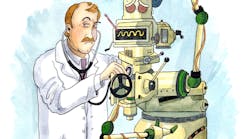If you were only casually listening to some of the presentations at Smart Industry 2017 you might have mistaken the conference for a gathering of medical professionals, what with all the talk of prevention and diagnostics and health. Machine health, of course, and preventive maintenance rather than preventive medicine, but close enough.
As industrial machines get smarter, they get softer, more sensitive, more human-like. And they must increasingly be treated in a manner that resembles medical care. Sound crazy? It ain’t. A recent study from market-research house Vanson Bourne found that 75% of IT and field-service leaders believe that machines will receive better preventive healthcare than human beings by 2020. That’s great news for expensive modern machinery and, perhaps, horrible news for worker who might fall into that machinery.
Just the fact that we’re using that term—healthcare—to apply to machines is indicative of the evolution in how we operate equipment in this digitally transformed era. There are direct parallels between what we traditionally consider “health” and the state of industrial machines. Health can be viewed as merely keeping things running—the fabricator continues spitting out parts, dad stays awake until falling asleep in the La-Z-Boy at 10 pm each night. Let’s consider that baseline health. Then there is optimal health, meaning that the plant is running at its best-possible rate with no unplanned downtime, and dad is keeping trim by running a 10K every Saturday. Let’s consider that fitness.
Fitness is the goal in both cases. The business owner wants a fit plant. Dad wants pants that fit. Same mindset.
Now, it might seem odd to take a delicate, nursely approach on the plant floor, where brawniness has traditionally been valued. But as machines or man become more intelligent, they often become more sensitive. I’m sure Einstein couldn’t take a punch.
Over at SmartIndustry.com we recently shared a post from Sarah Lukens who detailed how her work as a data scientist with GE Digital is informed by her prior job modeling infectious-disease transmission. “Yes, I did a little modeling in my younger years…”
As Sarah illustrates, there are direct parallels between the two fields. Patterns in data—regardless of what the data relates to—are similar and can yield actionable insights. If you know the flu is coming, you can gobble Vitamin C supplements and hunker down for a long nap. If you can predict that your extruder is about to crap out, you can order new parts and notify the technician. Both scenarios—man and machine—can include similar symptoms like slowed production and general shakiness, though if you contract a stomach bug your output might actually increase. (Sorry.)
At the core of all of this is the ability to see into the future: predictive maintenance (for machine) and preventive medicine (for man). When you know a problem is coming, you can handle it better when it arrives. If they’re properly informed and working strategically, production planners can schedule repair downtime during a slow period (say, the holiday season), just as you or I might schedule a dentist appointment during a week off from work, if you or I were to have lousy vacation-planning skills.
There’s a motto shared among the members of the Jackass crew, those raggedy stuntmen who sacrifice their bodies on film for the sake of a laugh. It goes like this: “If you wanna be dumb, you gotta be tough.” There’s a lot of truth to that—tough industrial machines can take a hit. But smart industrial machines will live longer, healthier, more productive lives.




